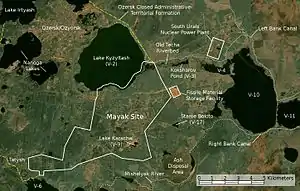Pollution of Lake Karachay
Lake Karachay, located in the southern Ural Mountains in eastern Russia, was a dumping ground for the Soviet Union's nuclear weapon facilities. It was also affected by a string of accidents and disasters causing the surrounding areas to be highly contaminated with radioactive waste. Although the lake has an area much smaller than that of the Fukushima Daiichi Nuclear Power Plant, and albeit the fact that three settlements, Ozyorsk, Novogornyj and Tatysh some 7 kilometers away are inhabited and that the lake is surrounded by Mayak, the lake is still technically a natural area and thus has been described as the "most polluted spot on Earth" by Washington, D.C.-based Worldwatch Institute.[1][2]

History
Built in the late 1940's, Mayak was one of Russia's most prominent nuclear weapons factories. The factory was kept secret by the government until 1990. When Russian president Boris Yeltsin signed a 1992 decree opening the area, Western scientists were able to gain access. The sediment of the lake bed is estimated to be composed almost entirely of high level radioactive waste deposits to a depth of roughly 11 feet (3.4 m).
In 1994, a report revealed that 5 million cubic meters of polluted water had migrated from Lake Karachay, and was spreading to the south and north at 80 meters per year, "threatening to enter water intakes and rivers".[3] The authors acknowledged that "theoretical hazards developed into actual events".
In November 1994, officials from the Russian Ministry of Atomic Energy stated that Soviet officials initiated a process following the 1957 Kyshtym disaster resulting in the transfer of 3 billion curies of high level nuclear waste into deep wells at three other sites.[4]
After a drought caused water levels to drop, revealing contaminated silt, which was then wind blown, further polluting surrounding areas, it was decided to completely fill in the lake. [5]As of December 2016, the lake's status is completely infilled, using special concrete blocks, rock, and dirt. It had been completely backfilled in November 2015, then monitored before placing the final layer of rock and dirt. Monitoring data showed "clear reduction of the deposition of radionuclides on the surface" after 10 months.[6] A decades-long monitoring program for underground water was expected to be implemented shortly after.[6]
The Techa River, which provides water to nearby areas, was contaminated, and about 65% of local residents fell ill with radiation sickness. Doctors called it the "special disease" because they were not allowed to note radiation in their diagnoses as long as the facility was secret. In the village of Metlino, it was found that 65% of residents were suffering from chronic radiation sickness. Workers at the plutonium plant were also affected.
Causes
The pollution of Lake Karachay is connected to the disposal of nuclear materials from Mayak. Among workers, cancer mortality remains an issue.[7] By one estimate, the river contains 120 million curies of radioactive waste.[8]
Prevalence of pollution
Nuclear waste, either from civilian or military nuclear projects, remains a serious threat to the environment of Russia.[9] Reports suggest that there are few or no road signs warning about the polluted areas surrounding Lake Karachay.[10]
Some parts of the lake are extremely radioactive (600 röntgens/hour) and one could receive a lethal dose of radiation in 30 minutes (300 röntgens).
See also
References
- Lenssen, "Nuclear Waste: The Problem that Won't Go Away", Worldwatch Institute, Washington, D.C., 1991: 15.
- Andrea Pelleschi (2013). Russia. ABDO Publishing Company. ISBN 9781614808787.
- Lavernov, N. P., B. I. Omelianeako, and V. I. Velichkin. 1994. Geological aspects of the nuclear waste disposal problem. Berkeley: Lawrence Berkeley Laboratory. Page 3.
- "Critical Masses: Citizens, Nuclear Weapons Production, and Environmental Destruction in the United States and Russia", by Russell J. Dalton, 1999, p.79
- "Lake Karachay, the most polluted spot on Earth". 2016-11-21.
- "Russia's Mayak continues clean-up of Lake Karachai". Nuclear Engineering International Magazine. Global Trade Media. 30 November 2016. Retrieved 24 December 2020.
- Shilnikova NS, Preston DL, Ron E, Gilbert ES, Vassilenko EK, Romanov SA, Kuznetsova IS, Sokolnikov ME, Okatenko PV, Kreslov VV, Koshurnikova NA (2003). "Cancer mortality risk among workers at the Mayak nuclear complex". Radiat Res. 159 (6): 787–98. Bibcode:2003RadR..159..787S. doi:10.1667/0033-7587(2003)159[0787:cmrawa]2.0.co;2. PMID 12751962.CS1 maint: multiple names: authors list (link)
- "Russia", p. 121, publisher = Lonely Planet
- "The Politics of Environmental Policy in Russia", p. 34, by David Lewis Feldman, Ivan Blokov
- "The Burning Lake: A Volk Thriller", by Brent Ghelfi, p. 101